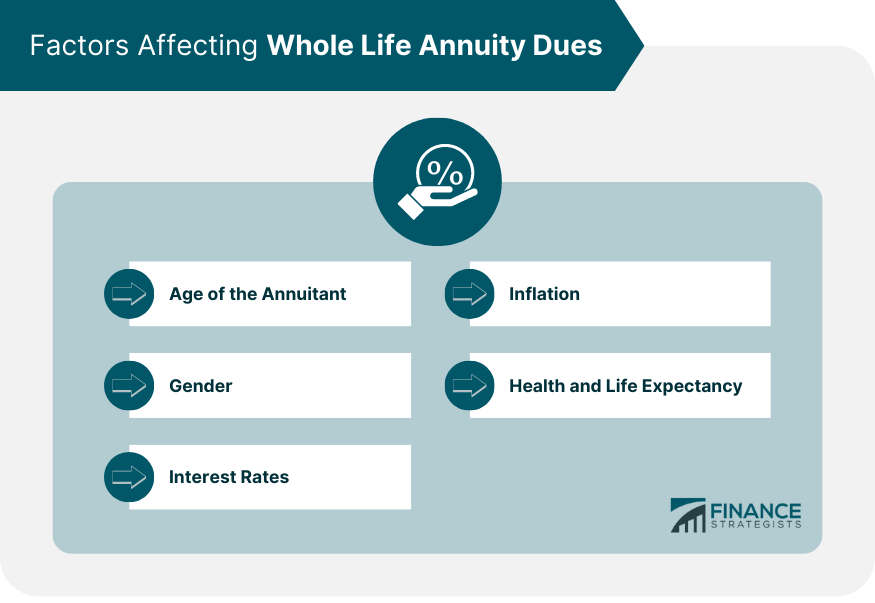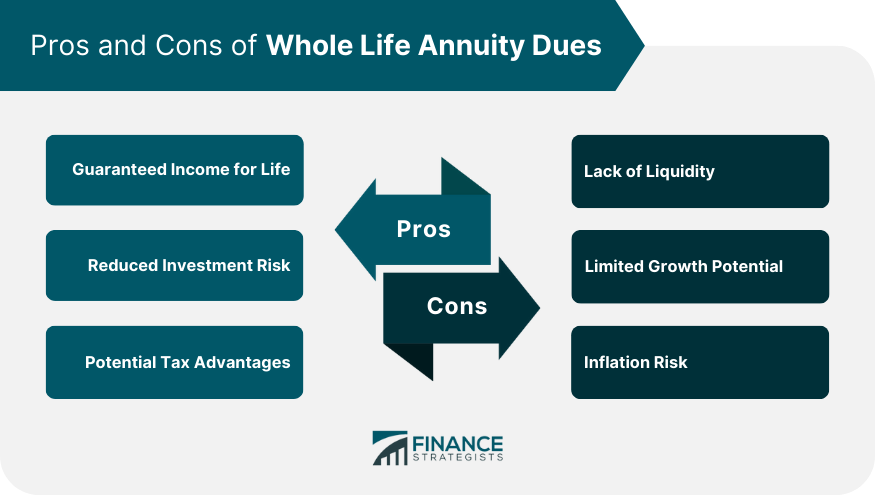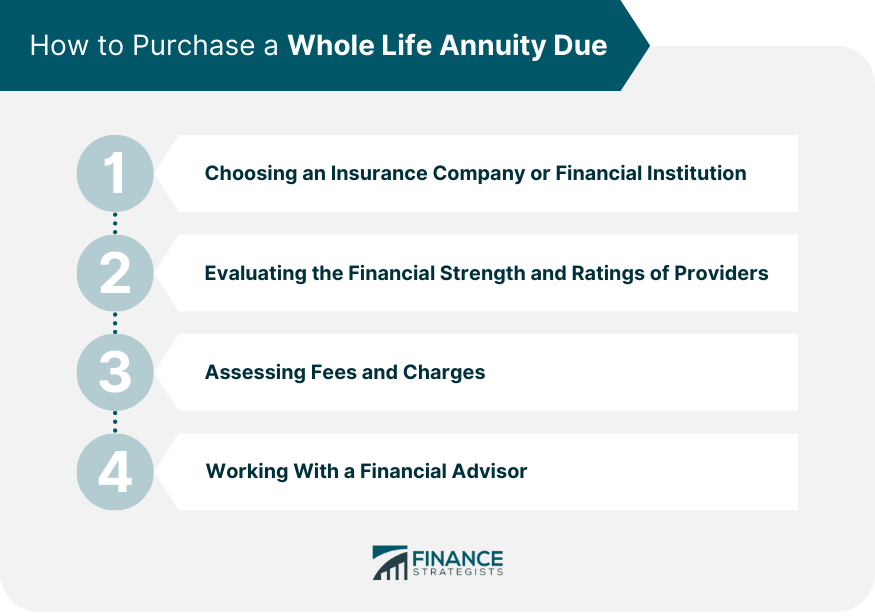A whole life annuity due is a financial product provided by an insurance company or financial institution that guarantees regular income payments for the lifetime of the annuitant (the person receiving the payments). The payments begin at the start of each period, which could be monthly, quarterly, or annually. The main purpose of a whole life annuity due is to provide a stable and predictable income stream for individuals, particularly retirees. This reduces the risk of outliving one's savings and provides peace of mind. Unlike other types of annuities, a whole life annuity due provides lifelong income, starting at the beginning of each payment period. In contrast, term certain annuities provide income only for a specified period. Payments in a whole life annuity due are made regularly for the life of the annuitant. This regularity offers a reliable income stream, particularly useful for retirees. The payment frequency is typically set when the annuity contract is established, and it can be monthly, quarterly, or annually. Depending on when you want the payments to start, you can choose either an immediate or deferred annuity due. Immediate annuities start paying right away, while deferred annuities begin payments at a future date. While the payments in a whole life annuity due are usually guaranteed, some contracts may offer non-guaranteed payments that can vary based on investment performance or other factors. The tax implications of whole life annuity due payments depend on several factors, including whether the annuity was purchased with pre-tax or after-tax dollars. The age of the annuitant at the time of purchase directly affects the amount of the annuity payments. Generally, older annuitants receive larger payments because they have a shorter expected lifespan. Gender can also affect annuity payments because women tend to live longer than men, resulting in smaller annuity payments for women of the same age. Interest rates at the time of purchase can impact the amount of the annuity payments. Higher interest rates typically result in higher payments. Inflation can erode the purchasing power of annuity payments over time. Some annuities offer a cost of living adjustment to help offset the effects of inflation. Health status and life expectancy can influence the decision to purchase a whole life annuity due. Those with longer life expectancies can benefit more from lifetime income payments. A single life annuity provides income for the life of one individual. In contrast, a joint life annuity provides income for the lives of two people, typically a married couple. A period certain option guarantees payments for a certain number of years, even if the annuitant dies within that period. A COLA option can help protect against the eroding effects of inflation by increasing the annuity payments each year based on a specific inflation measure. A cash refund or installment refund option guarantees that, if the annuitant dies before receiving payments equal to the purchase price of the annuity, the remaining amount will be paid to a designated beneficiary. One of the main benefits of a whole life annuity due is the guarantee of income for life, providing financial security particularly for retirees. With a whole life annuity due, investment risk is transferred to the insurance company, thus insulating the annuitant from market volatility. Depending on the type of funds used to purchase the annuity, there may be tax advantages associated with annuity payments. Once an annuity is purchased, the funds are typically locked in for a period of time, reducing liquidity. Annuities usually offer lower returns compared to other investment options like stocks or mutual funds. Unless the annuity has a COLA option, inflation can erode the purchasing power of the fixed annuity payments over time. Choosing a reputable and financially stable insurance company or financial institution is a critical step when purchasing a whole life annuity due. Financial strength and ratings of insurance companies and financial institutions are indicators of their ability to meet contractual obligations. These ratings should be checked with independent rating agencies such as A.M. Best, Moody's, Standard & Poor's, and Fitch Ratings. Understanding the fees and charges associated with a whole life annuity due is essential. These may include surrender charges, administrative fees, and investment management fees. Working with a qualified financial advisor can help in understanding the complexities of annuities and making informed decisions that align with individual financial goals and circumstances. Fixed annuities offer a guaranteed rate of return for a specified period. They are less risky but also offer lower returns compared to variable or indexed annuities. Variable annuities provide a return based on the performance of a portfolio of investments. While they have higher growth potential, they also carry more risk. Indexed annuities offer returns based on a stock market index, providing a balance between risk and return. Systematic withdrawal plans allow for regular withdrawals from an investment portfolio, providing flexibility and control over the income stream. A whole life annuity due is a financial instrument that guarantees a regular income stream for the life of the annuitant, starting at the beginning of each payment period. It serves as a critical tool for financial stability, particularly for retirees. However, this type of annuity comes with its own set of advantages and disadvantages. On one hand, it provides guaranteed income for life, reduces investment risk, and may offer potential tax advantages. On the other hand, it limits liquidity, has constrained growth potential, and may expose the annuitant to inflation risk. Personal factors such as age, health, life expectancy, and financial goals should be carefully considered when evaluating a whole life annuity due. Moreover, it's crucial to remember that this type of annuity is just one piece of the retirement planning puzzle. A comprehensive financial plan should also account for other considerations such as healthcare costs, estate planning, and other potential sources of income in retirement. Working with a financial advisor can be invaluable in navigating these complexities and ensuring a secure financial future.What Is a Whole Life Annuity Due?
Features of Whole Life Annuity Dues
Payment Structure
Regular Payments
Payment Frequency
Immediate or Deferred Annuity Due
Guaranteed and Non-guaranteed Payments
Tax Implications
Factors Affecting Whole Life Annuity Dues
Age of the Annuitant
Gender
Interest Rates
Inflation
Health and Life Expectancy

Whole Life Annuity Due Options
Single Life vs Joint Life Annuity
Period Certain Option
Cost of Living Adjustment (COLA) Option
Cash Refund or Installment Refund Option
Pros and Cons of Whole Life Annuity Dues
Advantages
Guaranteed Income for Life
Reduced Investment Risk
Potential Tax Advantages
Disadvantages
Lack of Liquidity
Limited Growth Potential
Inflation Risk

How to Purchase a Whole Life Annuity Due
Choosing an Insurance Company or Financial Institution
Evaluating the Financial Strength and Ratings of Providers
Assessing Fees and Charges
Working With a Financial Advisor

Alternatives to Whole Life Annuity Dues
Fixed Annuities
Variable Annuities
Indexed Annuities
Systematic Withdrawal Plans
Final Thoughts
Whole Life Annuity Due FAQs
A whole life annuity due is an insurance product that provides guaranteed lifetime payments to the annuitant, with payments starting immediately after the annuitant makes a lump sum payment.
A whole life annuity due works by allowing an annuitant to make a lump sum payment in exchange for regular payments that continue for the rest of their life. Unlike other annuity types, the payments for a whole life annuity due start immediately after the initial payment is made.
One of the benefits of a whole life annuity due is that it provides guaranteed lifetime payments to the annuitant. Additionally, the payments are usually fixed, which can provide peace of mind to the annuitant.
The main drawback of a whole life annuity due is that the annuitant must make a large lump sum payment upfront, which can be difficult for some individuals. Additionally, the payments are usually fixed, which can be a disadvantage if inflation increases significantly.
A whole life annuity due is suitable for individuals who want guaranteed lifetime payments and have a lump sum of money available to invest. It is also suitable for individuals who are concerned about outliving their retirement savings and want to ensure a steady stream of income.
True Tamplin is a published author, public speaker, CEO of UpDigital, and founder of Finance Strategists.
True is a Certified Educator in Personal Finance (CEPF®), author of The Handy Financial Ratios Guide, a member of the Society for Advancing Business Editing and Writing, contributes to his financial education site, Finance Strategists, and has spoken to various financial communities such as the CFA Institute, as well as university students like his Alma mater, Biola University, where he received a bachelor of science in business and data analytics.
To learn more about True, visit his personal website or view his author profiles on Amazon, Nasdaq and Forbes.











